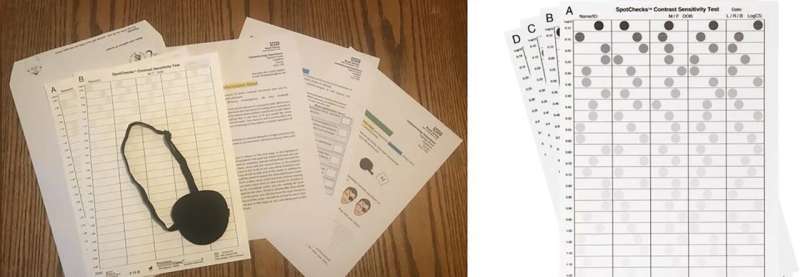This article has been reviewed according to Science X's editorial process and policies. Editors have highlighted the following attributes while ensuring the content's credibility:
fact-checked
trusted source
proofread
Using snail mail to prioritize cataract surgery waiting lists

A new study led by researchers from City, University of London and the Royal Surrey County Hospital NHS Foundation Trust has explored a novel low-tech approach to prioritize patients on cataract surgery waiting lists.
Published in the journal Eye, the study examined the potential of using a mailed pen-and-paper contrast sensitivity (CS) test to help identify people needing urgent cataract surgery.
Cataract wait times
The growing demand for cataract surgery, exacerbated by aging populations, has led to prolonged waiting times worldwide. The study sought to address this issue by investigating a cost-effective and scalable method to prioritize surgical intervention.
The research involved mailing tests to 233 individuals awaiting cataract assessment. Patients were asked to complete the tests at home, and then return them via prepaid envelopes. The response rate was better than expected, with 46% of patients responding. The home-administered CS test also demonstrated a good ability to predict which eyes were later listed for surgery.
Low-tech solution
Overall, the findings suggest that mailing patients pen-and-paper CS tests could be a feasible method to help manage cataract waiting lists more effectively. This low-tech solution offers a pragmatic approach to managing the increasing demand for cataract surgeries.
In addition, the study highlights the importance of continuing to innovate in patient care management. With the demand for cataract surgery expected to rise by 50% over the next two decades, scalable and cost-effective solutions are vital for sustaining health care systems.
Dr. Pete Jones, a Lecturer in Optometry and Visual Science at City, University of London, and one of the study's authors, emphasized the potential impact of this method.
He said, "By leveraging a simple, cost-effective test that patients can complete in the comfort of their homes, we can more accurately identify those who need urgent surgical intervention. This approach not only helps patients receive timely care but also optimizes the use of health care resources. We are also very grateful at City to have such productive collaborations with our NHS colleagues, and with the staff and patients at the Royal Surrey County Hospital in particular."
Dr. David Crabb, Professor of Statistics and Vision Research at City, added, "This is another example of how the Department of Optometry and Visual Sciences at City works with NHS partners with the aim of delivering impactful research that might be meaningful to patients."
More information: Eleonora Bianchi et al, Pushing the envelope: the feasibility of using a mailed contrast sensitivity test to prioritise cataract waiting lists, Eye (2024). DOI: 10.1038/s41433-024-03081-6


















